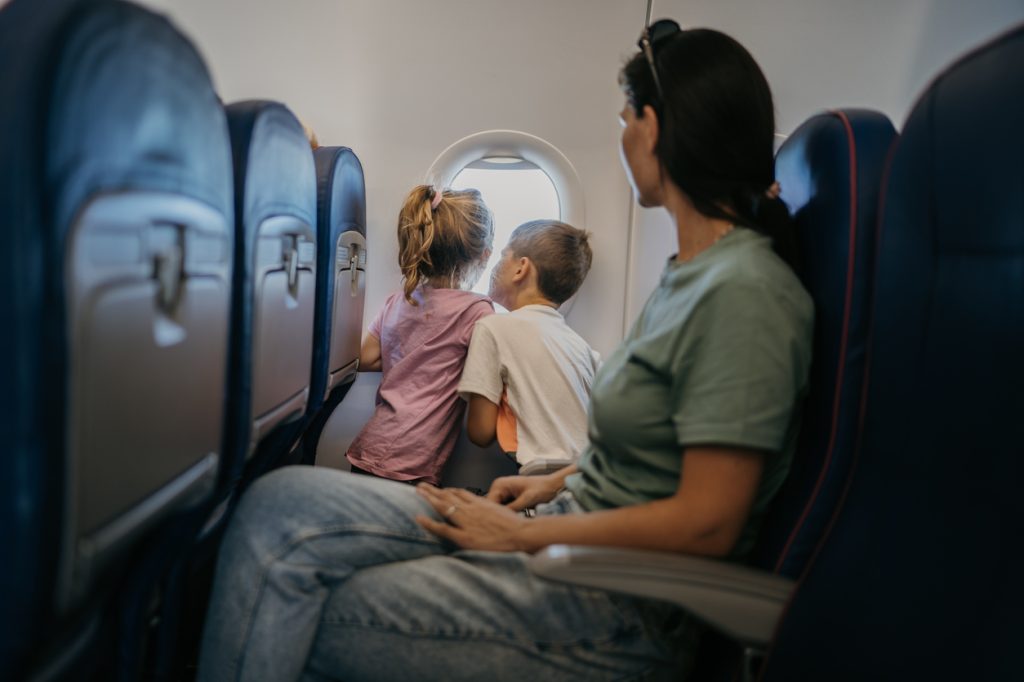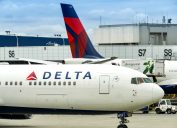Major Airlines, Including JetBlue and American, Are Changing Seating
The changes mean that children 13 and younger can sit with their family without a fee.

Despite all of the modern technology that makes it easier than ever to book a flight, there are still some headaches that can come with buying a ticket. Scoring your base airfare may not include basics like being able to bring a carry-on bag unless you pay an extra fee. Other carriers may charge you just to pick your seat, which can be especially difficult for those not traveling solo. But recently, major airlines—including JetBlue and American—have started changing their seating policies, which could make the whole process much easier for some passengers. Read on to see what this could mean for your next flight reservation.
RELATED: TSA Issues New Alert on What You Can't Bring Through Security.
It's now easier for families to sit together when flying JetBlue, thanks to a recent change.

It's arguably never been the easiest thing in the world to travel with young children, but the past few years have made it even more difficult for families. Changes to ticketing, the boarding process, and added fees have made it more complicated for parents who need to book adjacent seats for their kids. But last week, JetBlue announced a policy change that guarantees families will be able to sit next to each other on flights, per a press release from the airline.
The new rule states that all children 13 or younger will be sat next to at least one accompanying adult traveler for tickets booked on the same reservation. The change means that parents will no longer have to pay an extra fee typically charged for passengers who want to pick their seat assignments.
"We know traveling with young children can add challenges, and we want to do everything we can to put parents and families at ease by providing a smooth trip each time they choose JetBlue," Joanna Geraghty, the president and chief operating officer at JetBlue, said in the press release. "This enhanced family seating policy reflects our commitment to continue to meet the needs of our customers and provide exceptional service."
RELATED: 10 Clothing Items You Shouldn't Wear on a Plane.
Other major airlines, such as American and Alaska, have announced similar policies.

While it might appear like a rare victory for customers, JetBlue isn't the first major carrier to make these types of changes. American Airlines, Frontier Airlines, and Alaska Airlines also announced nearly identical policies earlier this year that will make it much easier for families to travel together, Travel + Leisure reports.
In each case, families who purchase basic economy tickets will get seat assignments so that children can sit next to at least one parent or guardian, pending availability and seat layouts. Notably, American Airlines extends the same rules for travelers who are 14 and under, according to T+L.
United Airlines also announced its own set of changes to its family seating policy in February. While it doesn't provide the same guarantee, the carrier released a "dynamic seat map" as of March that customers can use while booking flights to help secure consecutive assignments for children under 12 years old without fees on basic economy tickets, according to a press release from the airline.
RELATED: JetBlue Is Cutting Flights to 6 Major Cities, Starting Oct. 28.
Authorities have taken aim at "junk fees" that can make flying more expensive.

The surge in airlines making the skies more family-friendly comes after President Joe Biden announced plans to tackle the issue of "junk fees" forced on customers for basic conveniences. And while proposed legislation has not yet passed, airlines have already been getting ahead of the curve by ditching some fees—including nine that decided to stop charging passengers for changing flights amid delays and cancelations, Simple Flying reports.
The announcements also closely coincided with the U.S. Department of Transportation's (USDOT) release of its online family seating dashboard. The information hub allows passengers to check which carriers won't charge for booking adjacent seats for children, leading officials to praise companies who were proactive in adopting family-friendly changes.
"American Airlines, Alaska Airlines, and Frontier Airlines have stepped forward to guarantee that parents can sit with their young children without getting nickel and dimed," said the Department of Transportation in a statement in March, per CNN.
RELATED: 8 Airport Security Secrets TSA Doesn't Want You to Know.
Other airlines are experimenting with their own family booking policies.

While not all carriers have adopted guarantees, other major companies have begun experimenting with different family booking policies of their own. In late 2022, Southwest Airlines announced it was changing its unique boarding policies by allowing families with children 6 and younger to board before group A passengers on flights from Atlanta Hartfield Airport, Beat of Hawaii reported. Still, the changes would prohibit families from seating themselves anywhere within the first 15 rows of the aircraft.
Meanwhile, Delta Air Lines has maintained a separate policy that blocks solo travelers from booking specific seat assignments, reserving certain rows in the main economy cabin on flights for passengers traveling in groups of three or more, T+L reported. But the limited seats will still be available for selection by any travelers who hold "elite" platinum or diamond status with the airline's loyalty program.
RELATED: For more up-to-date information, sign up for our daily newsletter.





















